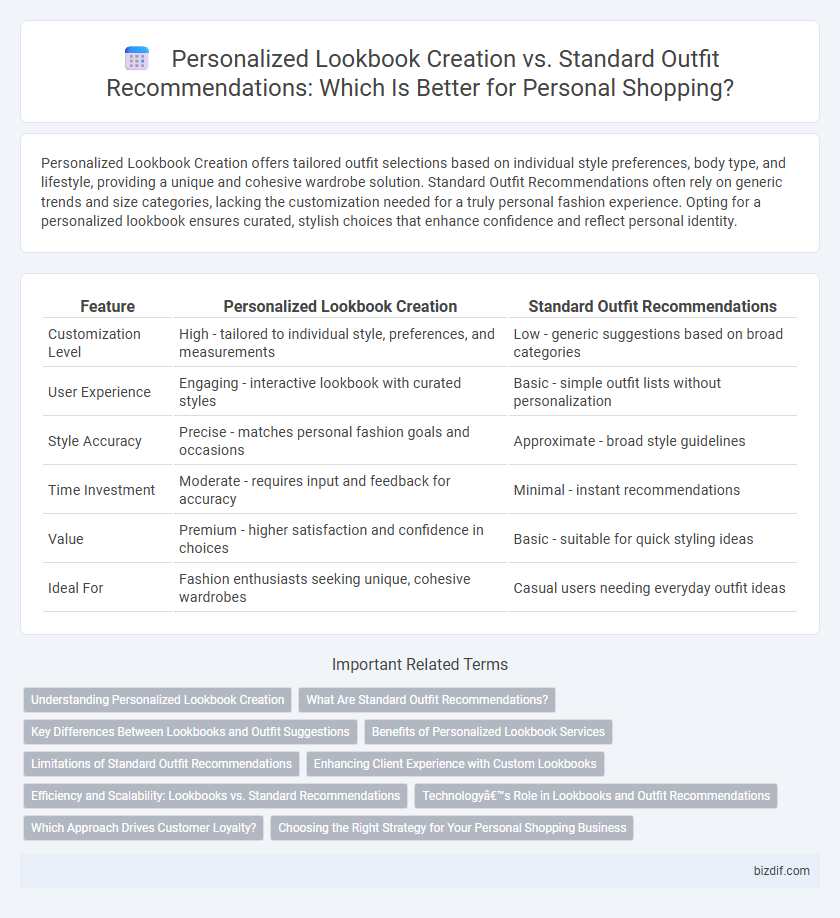Personalized Lookbook Creation offers tailored outfit selections based on individual style preferences, body type, and lifestyle, providing a unique and cohesive wardrobe solution. Standard Outfit Recommendations often rely on generic trends and size categories, lacking the customization needed for a truly personal fashion experience. Opting for a personalized lookbook ensures curated, stylish choices that enhance confidence and reflect personal identity.
Table of Comparison
| Feature | Personalized Lookbook Creation | Standard Outfit Recommendations |
|---|---|---|
| Customization Level | High - tailored to individual style, preferences, and measurements | Low - generic suggestions based on broad categories |
| User Experience | Engaging - interactive lookbook with curated styles | Basic - simple outfit lists without personalization |
| Style Accuracy | Precise - matches personal fashion goals and occasions | Approximate - broad style guidelines |
| Time Investment | Moderate - requires input and feedback for accuracy | Minimal - instant recommendations |
| Value | Premium - higher satisfaction and confidence in choices | Basic - suitable for quick styling ideas |
| Ideal For | Fashion enthusiasts seeking unique, cohesive wardrobes | Casual users needing everyday outfit ideas |
Understanding Personalized Lookbook Creation
Personalized Lookbook Creation involves curating a tailored collection of outfits based on an individual's unique style preferences, body type, and lifestyle, offering a more accurate and engaging shopping experience compared to standard outfit recommendations. This method leverages advanced algorithms and personal data to provide highly relevant clothing combinations that enhance customer satisfaction and confidence. By focusing on personalized styling insights, lookbooks help shoppers visualize complete ensembles, simplifying decision-making and boosting purchase likelihood.
What Are Standard Outfit Recommendations?
Standard outfit recommendations consist of pre-selected clothing combinations based on general style trends or popular choices without considering individual preferences or measurements. These suggestions rely on broad demographic data, such as age or gender, and commonly feature classic pieces or seasonal essentials. Unlike personalized lookbooks, they do not adapt to unique body types, personal tastes, or lifestyle needs, limiting their effectiveness in achieving a tailored wardrobe.
Key Differences Between Lookbooks and Outfit Suggestions
Personalized lookbook creation offers curated, cohesive collections tailored to an individual's style, preferences, and body type, unlike standard outfit recommendations that provide generic, one-off clothing suggestions. Lookbooks emphasize storytelling and visual inspiration through multiple coordinated outfits, enhancing user engagement and aiding long-term wardrobe planning. Standard recommendations focus on immediate, practical outfit ideas without deeper customization or thematic consistency.
Benefits of Personalized Lookbook Services
Personalized lookbook creation tailors outfit selections specifically to an individual's style preferences, body measurements, and lifestyle, resulting in a more accurate and satisfying shopping experience. This service offers cohesive, curated looks that enhance wardrobe versatility and reduce decision fatigue, unlike standard outfit recommendations that often use generic algorithms. By leveraging detailed personal data and fashion expertise, personalized lookbooks increase customer engagement and boost confidence in styling choices.
Limitations of Standard Outfit Recommendations
Standard outfit recommendations often fail to account for individual style preferences, body shape variations, and lifestyle needs, leading to generic and less satisfying suggestions. These one-size-fits-all solutions lack the adaptability to reflect evolving fashion trends and personal tastes accurately. Personalized lookbook creation leverages detailed customer data to deliver tailored, cohesive ensembles that enhance user engagement and satisfaction.
Enhancing Client Experience with Custom Lookbooks
Personalized lookbook creation enhances client experience by delivering tailored style suggestions based on individual preferences, body type, and lifestyle, resulting in higher satisfaction and engagement. Unlike standard outfit recommendations, custom lookbooks offer cohesive, curated ensembles that inspire confidence and streamline wardrobe decisions. This approach leverages advanced styling algorithms and client data analytics to provide a uniquely personalized shopping journey.
Efficiency and Scalability: Lookbooks vs. Standard Recommendations
Personalized lookbook creation enhances efficiency by curating cohesive outfit collections tailored to individual style preferences, reducing decision fatigue and streamlining shopping experiences. This method scales effectively across diverse customer segments using AI-driven algorithms that adapt to personal data, unlike standard outfit recommendations that often rely on generic, one-size-fits-all suggestions. The scalability of lookbooks accelerates engagement and boosts conversion rates through targeted, visually appealing content customized to evolving fashion trends.
Technology’s Role in Lookbooks and Outfit Recommendations
Advanced AI algorithms enhance personalized lookbook creation by analyzing individual style preferences, body measurements, and occasion specifics, resulting in highly tailored wardrobe suggestions. Standard outfit recommendations typically rely on generalized trend data and seasonal collections, offering limited customization. Technology's role in lookbooks leverages machine learning and computer vision to generate dynamic, interactive style guides, significantly improving user engagement and satisfaction.
Which Approach Drives Customer Loyalty?
Personalized lookbook creation significantly enhances customer loyalty by offering tailored fashion inspiration that aligns with individual tastes, body types, and lifestyle preferences, fostering a deeper emotional connection with the brand. Standard outfit recommendations often rely on generic trends and fail to engage customers on a personal level, leading to lower retention rates. Data shows that personalized style guides increase repeat purchase rates by up to 30%, highlighting their effectiveness over traditional suggestion methods.
Choosing the Right Strategy for Your Personal Shopping Business
Personalized Lookbook Creation offers a tailored visual guide that enhances customer engagement by showcasing curated outfits matching individual preferences and body types, resulting in higher conversion rates. Standard Outfit Recommendations provide a quicker, cost-effective solution but often lack the nuanced personalization necessary for building strong client relationships. Selecting the optimal strategy depends on business goals, with personalized lookbooks driving brand differentiation and customer loyalty in competitive markets.
Personalized Lookbook Creation vs Standard Outfit Recommendations Infographic

 bizdif.com
bizdif.com